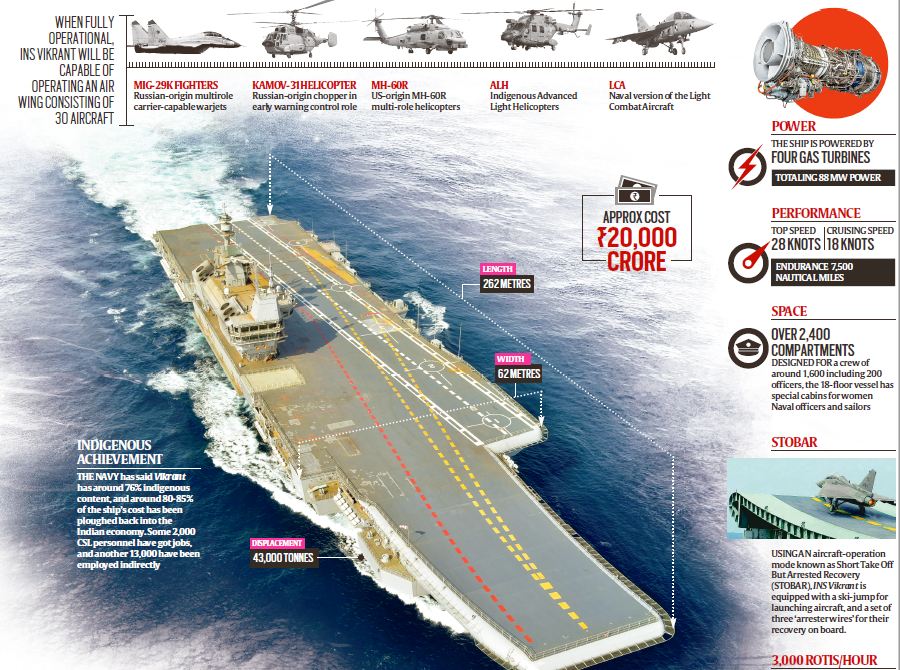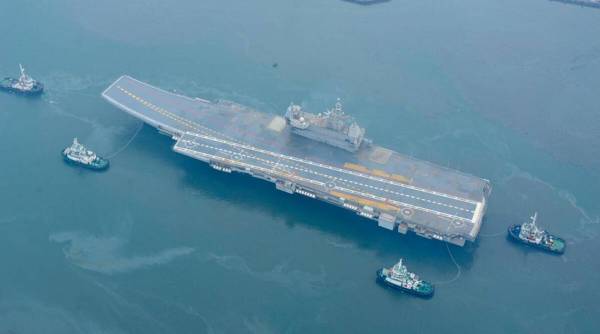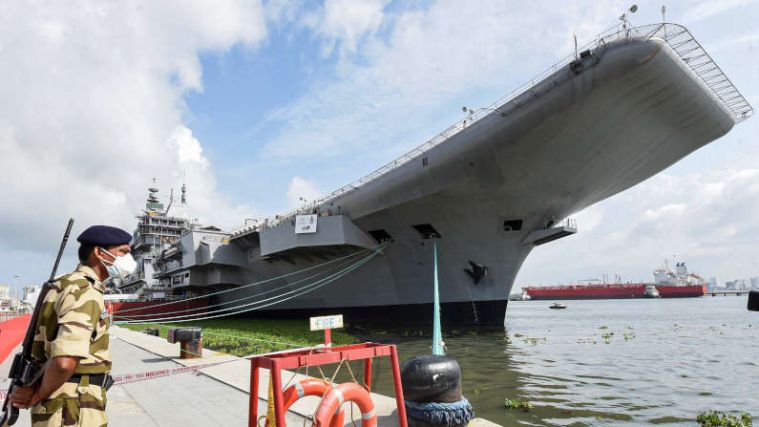Source : The Indian Express
 |
| INS Vikrant (R11) |
The commissioning of India’s first Indigenous Aircraft Carrier (IAC-1) into the Navy as INS Vikrant marks a defining moment. The first ever aircraft carrier to be indigenously designed and constructed, INS Vikrant will strengthen the country’s standing as a ‘Blue Water Navy’ — a maritime force with global reach and capability to operate over deep seas.
With it, India also joins the elite group of nations – the US, Russia, France, the UK and China – who are capable of designing and constructing aircraft carriers. Also, with a displacement of 43,000 tonnes when fully loaded, INS Vikrant is set to be the seventh largest among the carriers or carrier classes in the world.
The R11 legacy
INS Vikrant, with pennant number R11, was the first-ever aircraft carrier that was operated by the Indian Navy.
The ship was officially laid down in 1943, and was being built for the Royal Navy as HMS (Her Majesty’s Ship) Hercules when the constitution was put on hold after World War II ended.
Like many other ships at the time, the under-construction HMS Hercules was put up for sale by the United Kingdom, and was purchased by India in 1957. The construction work was completed and the ship was commissioned in the Indian Navy as INS Vikrant in 1961.
The ship operated its aircraft fleet with a catapult assisted system and ski-jump during its service.
Compared to the new INS Vikrant, the old one had less than half its displacement and was over 210 metres in length against 260 metres of the present one.
R11 saw significant action during the 1971 war with Pakistan when it led the Naval blockade of East Pakistan. The ship was decommissioned in 1997 after 36 years of service. Over the next 15 years, it was preserved as a museum ship before being finally sold to be dismantled.
Onward: The name, the motto, pennant number and the spirit
The Sanskrit word Vikrant, which means courageous, finds its origins in various scriptures including the Bhagwad Gita. The sixth shloka in the first chapter of the Gita, while describing the valour of some Generals from the army of Pandavas, uses the adjective ‘Vikrant’.
As far as the origin of the word goes, the ‘Vi’ prefix in the Sanskrit word denotes something that is distinctive or extraordinary, and the ‘krant’ suffix means to move or advance in a direction.
The word Viraat which means magnanimous, can also be found in the same chapter of Gita in a later verse and is the name of the now decommissioned and dismantled British-origin Centaur-class aircraft carrier of the Indian Navy.
“The induction and reincarnation of Vikrant is not only another step towards strengthening our defence preparedness, but also our humble tribute to the sacrifices made by our freedom fighters for the Independence of the nation and our brave soldiers during the 1971 war.” the Indian Navy has said.
Along with the pennant number R11, the newly commissioned INS Vikrant also carries forward the motto of its predecessor – “Jayema Sam Yudhi Sprudhah” – from the Rigveda which means: “I conquer those who fight against me”.
But what gives context to this motto is the previous part of this verse in Rigveda which, while addressing Hindu deity Indra, says: “Strengthened by the thunderous weapon given by you, we conquer…”
When fully operational the mighty aircraft carrier will not just be a strong deterrent but also act as a floating airbase on blue waters and will be a sovereign territory of India in the middle of the oceans.
Indigenous design and construction
The plan for building an indigenous aircraft carrier started taking shape as the old INS Vikrant neared its decommissioning in the late 1990s.
After it was retired, India relied on INS Viraat, which had then been serving the Indian Navy for over 10 years, after its earlier 25 year stint with the Royal Navy as HMS Hermes.
Meantime, the design and construction of the Indigenous Aircraft Carrier-I (IAC-I) was sanctioned in January 2003. Cochin Shipyard Ltd (CSL), a public sector shipbuilding entity under the Ministry of Shipping, was tasked to build the ship. This was the first warship construction project for the CSL.
Milestones along the way
The first major milestone for IAC – also referred to as Project 71 (P71) — was ceremonial steel cutting in April 2005. Other ceremonial events followed soon.
In any ship’s life there are four key ceremonial occasions – keel laying, launching, commissioning and decommissioning.
Keel laying ceremony originates from the tradition of laying one central timber that forms the backbone of the ship. For modern ships, keel laying is marked by placing the first of the modular components of the ship being placed in the dock. The keel of the IAC-I was laid on February 28, 2009.
Launching is when the ship is transferred from the building site into the waters. The IAC was launched on August 12 in 2013 and by that time, 80% of its structure had been fabricated and all the major machinery including turbines, alternators and gearboxes were installed.
The IAC was launched out into the Ernakulam Channel in a pontoon assisted precision manoeuvre. It was moved out of the building dock to be positioned in the refitting dock where the next phase of outfitting was completed. On June 10, 2015, the IAC was undocked.
The trials and pandemic-induced delays
The readiness of IAC’s propulsion and power generation equipment and related systems was tested in harbour as part of basin trials in November 2020.
The sea trials were delayed because of the second COVID-19 wave.
Finally on August 4 last year, the first phase of sea trials kicked off with the IAC sailing on its first open sea voyage from Kochi, and returning four days later.
This was followed by second and third phases of sea trials in October 2021 and January this year, respectively.
These three phases tested the propulsion machinery, electrical and electronic suites, deck machinery, life-saving appliances, ship’s navigation and communication systems. Fourth and final phase of sea trials for the IAC was completed on July 10 after conducting integrated testing of the majority of the equipment and systems onboard, including some of the Aviation Facilities Complex equipment. The ship was delivered to the Navy on July 28.
The equipment, amenities and apparatus onboard
The INS Vikrant is 262 metres long and 62 metres wide, making its flight deck bigger than two football fields. The aircraft carrier displaces around 4,3000 tonnes when fully loaded, with a maximum designed speed of 28 knots with endurance of 7,500 nautical miles, which is equivalent to around 14,000 km.
The 18-floor high ship has close to 2,400 compartments, designed to house 1,600-strong crew. It also has specialised cabins to accommodate women officers and sailors. The aviation hangar is as big as two Olympic-size pools that can accommodate around 20 aircraft. There is a well-equipped kitchen that can serve a diverse menu. It also has a unit that makes 3,000 rotis per hour.
Its medical complex has a 16-bed hospital along with modular emergency operation theatre, physiotherapy clinic, Intensive Care Unit, pathology set up, radiology wing with a CT scanner and X-Ray machines, a dental complex, isolation ward and telemedicine facilities.
In its fully operational mode, the carrier will have an air wing consisting of 30 aircraft comprising of Russian-origin, carrier-capable MiG-29K fighter jets and airborne early warning control helicopter Kamov-31 helicopters, US origin MH-60R multi-role helicopters, in addition to homegrown Advanced Light Helicopters (ALH) and Light Combat Aircraft (LCA) (Navy). Vikrant uses the Short Take Off but Arrested Recovery (STOBAR) model with a ski-jump for launching aircraft, and a set of three arrester wires for their recovery onboard.
The path ahead after commissioning
Vikrant has been built at an approximate cost of Rs 20,000 crore. The Navy has said that around 80 to 85% has been ploughed back into the Indian economy with complete indigenous construction, 76% indigenous content and with employment given to 2,000 CSL personnel with another 13,000 being employed indirectly.
On operationalising INS Vikrant, the Navy has said, “In line with the prevailing practices being followed by other advanced countries having experience of building aircraft carriers, the deck integration trials of fixed wing aircraft and exploitation of Aviation Facility Complex will be carried out post commissioning of the ship when the operational command and control of the ship, including flight safety, is with the Navy.”
The flight trials of INS Vikrant are set to begin by November and the carrier is expected to be fully operational by mid-2023, Vice Chief of Naval Staff, Vice Admiral SN Ghormade said.
The cost of building and operating aircraft carriers
However, senior officials said that the decision to give a nod to construct IAC-II not just has political, economic and strategic considerations, but also one of India’s projected standing as a global maritime power. The decision also needs to be looked at from the standpoint of how China is rapidly pursuing its carrier programme with their third carrier already in the making and more in the pipeline, officials said.









